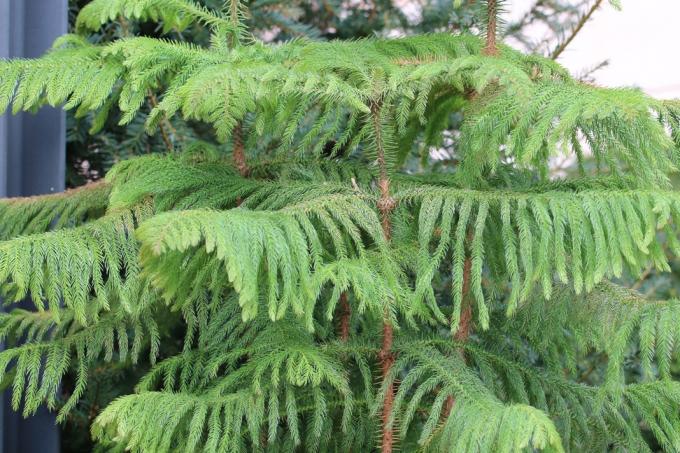
table of contents
- growth
- care
- Location
- Planting time
- to water
- Fertilize
- Cut
- Multiply
- Diseases
- Pests
Profile and care information open +conclude -
- Location
- the shade
- Growth habit
- bushy
- height
- up to 60 cm
- Soil type
- sandy, loamy
- Soil moisture
- moderately dry, moderately moist
- PH value
- neutral, slightly acidic
- Limescale tolerance
- Calcium intolerant
- humus
- rich in humus
- Poisonous
- no
- Plant families
- Araucarias, Araucariaceae
- Plant species
- Small trees, potted plants
- Garden style
- Pot garden, winter garden
The common fir Araucaria heterophylla is known by many names. As a Norfolk fir or Andean fir, it reaches a height of up to 60 m in the wild. In the room, on the other hand, the tree with the lively branches rarely grows higher than 1.80 m. The fir tree originally comes from the Australian Norfolk Islands and is relatively easy to care for. However, hobby gardeners who are enthusiastic about conifers should definitely deal with the topic of correct pruning of the trees: Otherwise the fir tree will simply be too high.
growth
Araucaria heterophylla rises majestically in imposing entrance halls, stretches out its branches in representative floorboards and creates clear relationships in well-proportioned living spaces. It is the only species of Araucaria that can be grown indoors. Araucaria heterophylla is an ornament when cut regularly.
The indoor fir is not very easy to care for, it needs a special substrate, has to be watered and sprayed regularly and needs to be fertilized. Hobby gardeners who can come to terms with regular care will still enjoy this conifer.
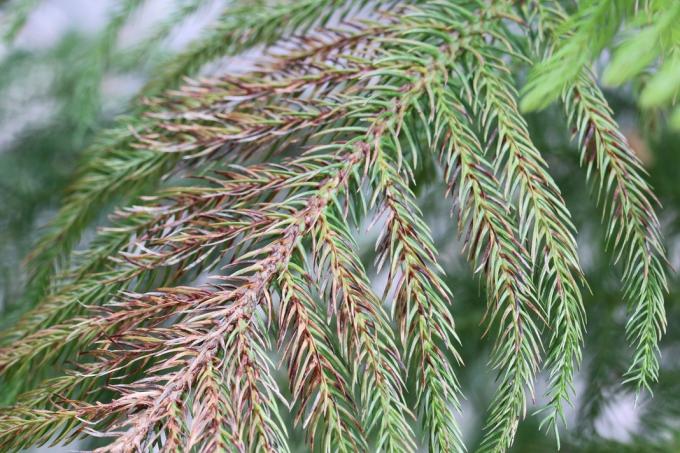
In the wild, the Norfolk fir can reach heights of up to 60 m. The conifer loves the frost-free, mild climate of the Australian Norfolk Islands, but needs a cool location of around 5 ° C to 10 ° C in winter. It does not like waterlogging, tolerates brief morning and evening sun quite well, but otherwise prefers the shade. The room fir should be watered and sprayed regularly, and it needs a humidity level that is constant at around 80%.
care
Behind the astonishing idea of keeping a conifer in the apartment is one that is actually quite easy to care for and Living room-friendly conifers that have exactly the right proportions in large, bright rooms and a piece of nature in closed rooms Brings spaces.
Location
The room fir does not like direct sun, but it doesn’t tolerate a bit of morning and evening sun. Otherwise, a shady location with enough space is very good. It should definitely be bright, because the indoor fir only has something against direct sunlight, it does not need shade. It is problematic if the room is heated all year round.
Because the room fir needs moderate temperatures of around 18 ° C to 23 ° C in summer, 5 ° C to 10 ° C is sufficient in winter. In addition, the fir tree likes a constant humidity of around 80%, which is difficult to implement in rooms that are mostly the same temperature all year round today. The room fir can be sprayed repeatedly with warm water to achieve this.
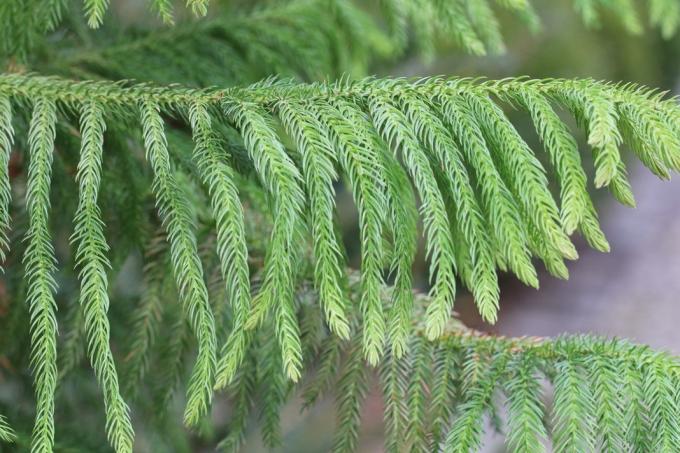
If it is constantly at least 10 ° C to 15 ° C warm outside, the room fir can also stand on the balcony or veranda. However, it must be ensured here that the tree does not get direct sun, especially at noon. Your Norfolk fir will grow particularly evenly if you turn it around 20 ° at regular intervals.
Soil condition
The room fir does not place too high demands on the floor. She doesn't like being too sour, a pure one rhododendron-You don't like earth.
The fir tree needs:
- slightly acidic, loose soil
- fresh-moist to moderately dry
- sandy-loamy, loose and well-drained
Avoid waterlogging, because the indoor fir does not like it. A well mixed substrate with some gravel and a coaster filled with stones and water are very suitable good as drainage, in order to simultaneously provide an adequate supply of moisture via the earth as well as in the air to ensure.
Substrate
The room fir is expressly kept in the room, so only the self-made mixture in the bucket can be used as a substrate. Commercial potting soil can be enriched with peat, bog soil or azalea soil. It is advisable to add perlite, sand or pumice to get good drainage.
Because the room fir does not like waterlogging. Alternatively, you can offer your Norfolk fir a substrate made from garden soil, compost, bark mulch and grit. It is important that the room fir has space in a sufficiently large bucket to spread its roots in a slightly acidic substrate and that excess water can easily drain off.
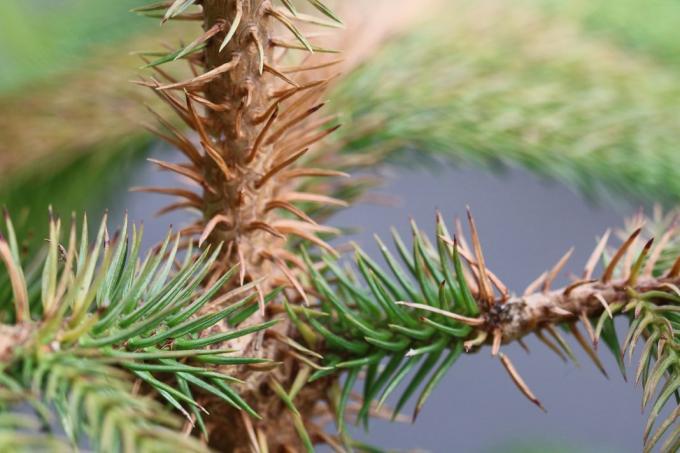
Planting time
Your indoor fir will want to be planted in a larger pot with fresh substrate when it comes out of the garden center or the nursery. As a rule, the trees are in much too narrow pots, which permanently impede their growth. Buckets with a hole in the bottom are suitable as a water drain, over which a drainage made of gravel or pumice is laid.
Plants in the bed
Since the Norfolk fir wants to stand frost-free all year round and prefers moderate temperatures in summer, planting in bed is not advisable. At least in German latitudes, the Norfolk fir is a pure potted plant that has no place in the field. On mild days between spring and autumn, however, the conifers can stand in their pots on the balcony or veranda, provided that they can stay in the shade. Because she doesn't like overly sunny locations.
Plants in the pot
Prepare the bucket as described above. An air and water permeable fleece over the drainage keeps the soil out and prevents the drainage from clogging. Before you put your Norfolk fir in the newly designed bucket, put the root ball in a bucket of water. It stays there until no more air bubbles rise.
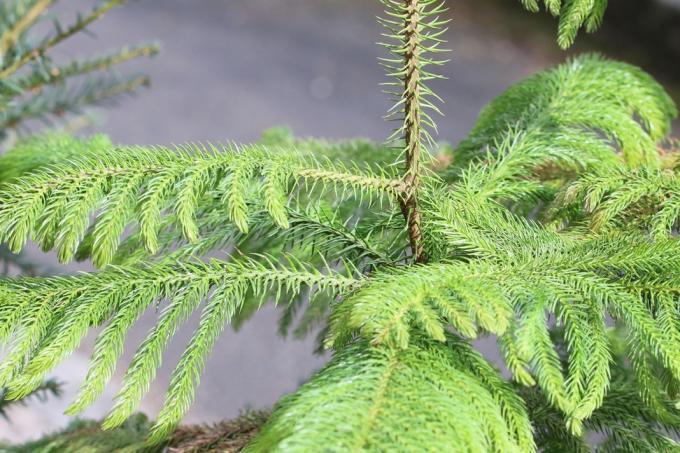
Meanwhile, spread a layer of substrate over the fleece and drainage in the bucket. Place your juvenile conifer on this layer, in the middle of the pot or bucket. Press the earth lightly with your fist again and again so that no cavities form. Gradually fill in enough substrate so that your room fir is only as deep in the ground as it was before.
Planting them deeper can cause stem rot to develop. Do not fill the pot to the top with substrate, but leave a pouring rim about 5 cm high. In this way, the water-substrate mixture later remains in the bucket and does not spill over onto the floor.
to water
The Norfolk fir comes from a subtropical climate zone in which there are only two seasons: the rainy, mild vegetation phase between April and September, and the cooler, dry winter break between October and March.
As a hobby gardener, you should adjust watering and fertilization behavior accordingly:
- you should water abundantly in spring and summer
- the root ball must not dry out at any time, but waterlogging must not form either
- there is always more water when the surface has dried out
- please only use collected rainwater or decalcified water
- If your room fir is on a coaster without pebbles, you should empty it after 20 minutes at the latest
Fertilize
During the main growth phase, pamper your Norfolk fir with a liquid fertilizer every 14 days. Hobby gardeners swear by azalea fertilizer because it comes closer to the needs of conifers than the special preparations for fir trees or other green plant fertilizers.
Nitrogen overfertilization causes the branches of your fir tree to grow extremely elongated - this is undesirable and should be prevented. Because the long branches are too heavy for the plant and hang limply. From August you should no longer fertilize your indoor fir so that the shoots can mature for the winter break.
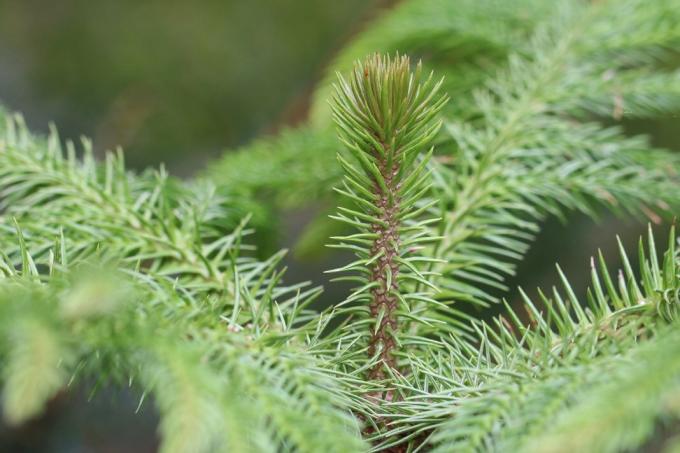
Cut
The European fir is a conifer, and like many other conifers, it does not sprout from woody parts. Therefore, a cut is quite difficult. Fruit trees and other trees in nature need regular pruning to maintain their vitality and health. This is different with your araucaria plant, here the cut is rather counterproductive.
It is more advisable to snap on from below. Latching means that individual branches are removed except for the astring on the trunk, so that only the crown remains on top. Branches that have grown too long can be diverted. To do this, cut off the branch of a branch in such a way that the neighboring, shorter branch takes on the function of the tip. You should never cut off the top of a room fir, but rather pry open the tree from below.
Overwinter
Araucaria heterophylla enters the winter phase between late September and early October. Now the conifer should be moved to a room that is not heated in winter. If it is in a normally heated room, the room fir has to move.
A slightly heated entrance hall, on the other hand, is fine, and the unheated winter garden is also a good location during the cold months.
Adapted watering and fertilizing behavior is also part of wintering:
- Temperatures between 5 ° C and 10 ° C are ideal
- During the winter months, the indoor fir should only be watered a little: the watering amount should be so small that the root ball does not dry out, nothing more
- there is no fertilization in winter
- Occasionally the conifer should be sprayed with a little soft water
- the cooler the room, the less irrigation water and humidity the room fir needs
- on frost-free days it should be aired regularly

Multiply
The propagation of the indoor fir is not that easy. If you want to try that, please bring some experience, a lot of patience and a high tolerance for frustration.
sowing
Make sure that you only use fresh seeds from specialist shops. Ideally, sow in early spring. The seed pots should be filled with a mixture of peat and sand, and only one seed may be put into each pot. Cover the substrate and seeds with the damp sphagnum.
In the following period there is no watering because the risk of rot is very high. During the summer months, you should set up the nursery pots in a shady, well-ventilated room with temperatures between 18 ° C and 23 ° C. The required moisture is taken from the air, pouring is not desirable. The first small plants that you can overwinter in the house should have developed by autumn.
Temperatures between 10 ° C and 12 ° C are required. When watering, the same applies here as with adult plants: The root ball must not dry out, but very little is watered. As a rule, it takes about three years for a separate indoor fir to develop after sowing, which is treated like an adult conifer.
Cuttings
- use only head cuttings
- the pruning should take place in winter
- there must be a branch whisk and a central bud
- make the cut about 4 cm below the branch whisk
Fill a nutrient-poor substrate into pots 9 cm in diameter. The seedling is planted so deep that the knot is directly above the ground. The substrate is moistened with lime-free water. To ensure that the moisture is retained, you should stretch a sheet of plastic over the container. Keep the temperature constant at around 18 ° C to 22 ° C. Rooting should take place within 2 to 3 months. To prevent mold formation, you should ventilate the film daily.

Interfaces do not grow closed again in room firs. For this reason, hobby gardeners usually sow indoor firs and cultivate the plants for around three years. At this point, the conifers that have moved are large enough to produce beautiful seedlings. These young seedlings then develop into shapely, youthful Norfolk firs within a few months, and the elegant appearance of the firs is not disturbed.
Diseases
The only disease worth mentioning that troubles the Norfolk fir in the bucket is stem rot: Von der The base of the shoot forms a brownish discoloration that spreads and causes the plant to die leads.
Pests
Thrips
Light, small sucking spots are formed, and about 1mm large animals and larvae can be found. The so-called fringed wings or bladder feet are rather inconspicuous, not least because of their small size. Thrips occur in many different species in Europe, some of which can only survive in greenhouses.
So it is possible that your conifer has already picked up the pests from the nursery or garden center brings along, because thrips are only able to fly to a limited extent, but can sometimes go quite far leap. They overwinter in the ground and feed on plant sap.
Mealybug
You won't see mealybugs themselves. the animals are covered by white wax threads and sit on the shoot tips and leaves of the conifers. They hardly move, but are often soiled with honeydew and sooty fungi. The control of mealybugs is only possible with special means that the fir tree must be able to tolerate.


